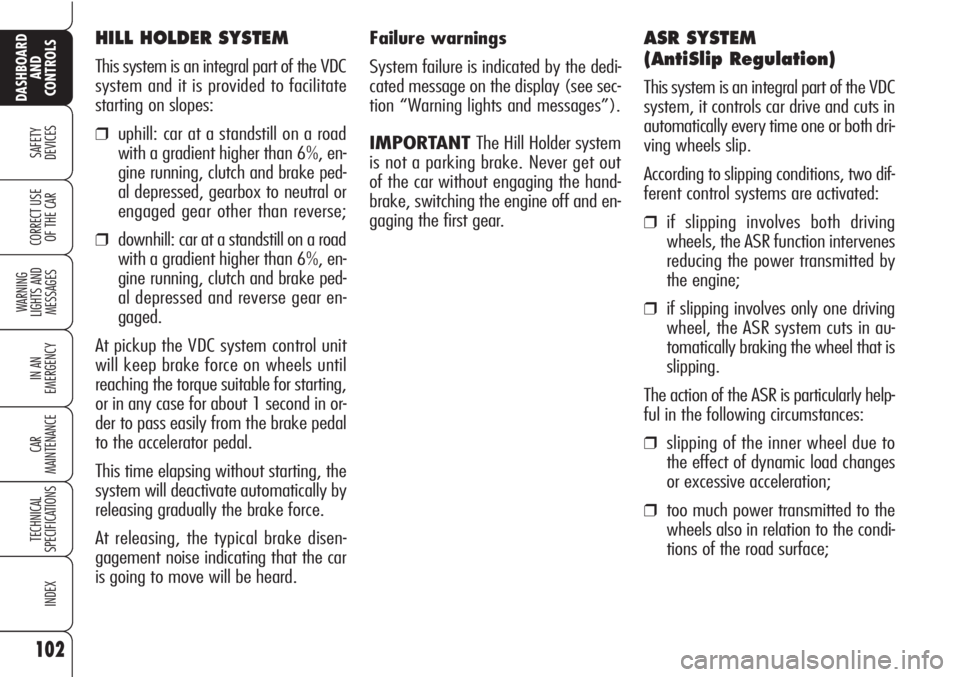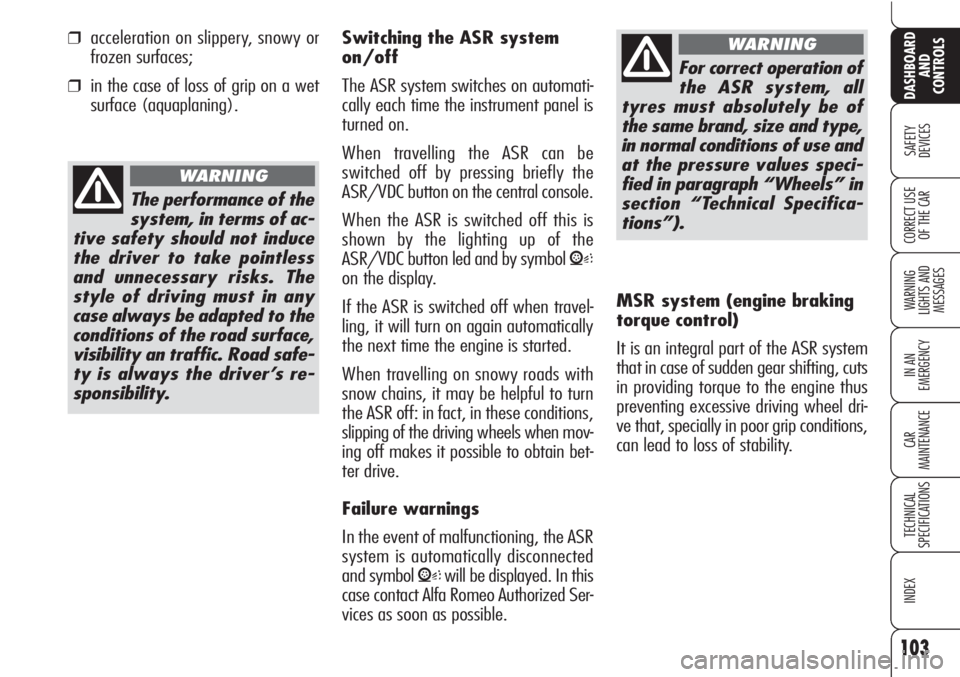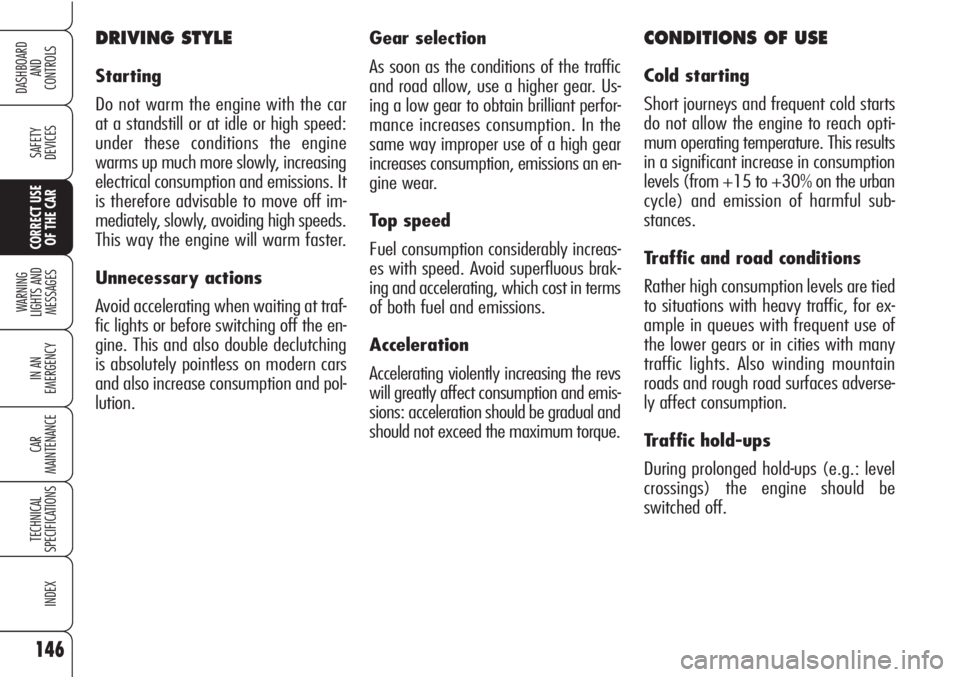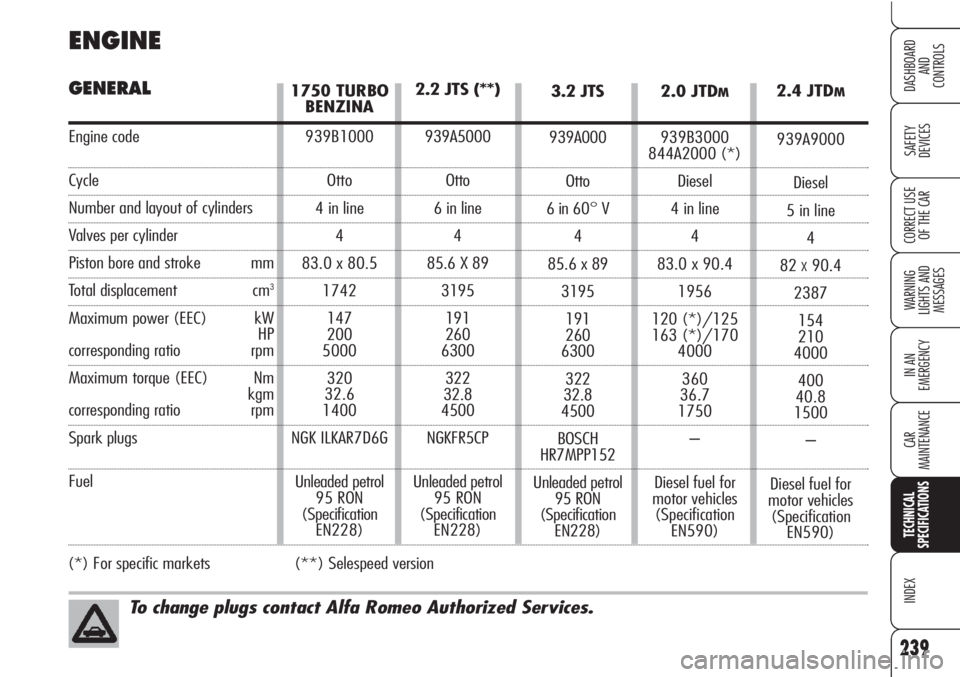torque Alfa Romeo Brera/Spider 2010 Owner handbook (in English)
[x] Cancel search | Manufacturer: ALFA ROMEO, Model Year: 2010, Model line: Brera/Spider, Model: Alfa Romeo Brera/Spider 2010Pages: 271, PDF Size: 4.45 MB
Page 104 of 271

102
SAFETY
DEVICES
WARNING
LIGHTS AND
MESSAGES
IN AN
EMERGENCY
CAR
MAINTENANCE
TECHNICAL
SPECIFICATIONS
INDEX
DASHBOARD
AND
CONTROLS
CORRECT USE
OF THE CAR
HILL HOLDER SYSTEM
This system is an integral part of the VDC
system and it is provided to facilitate
starting on slopes:
❒uphill: car at a standstill on a road
with a gradient higher than 6%, en-
gine running, clutch and brake ped-
al depressed, gearbox to neutral or
engaged gear other than reverse;
❒downhill: car at a standstill on a road
with a gradient higher than 6%, en-
gine running, clutch and brake ped-
al depressed and reverse gear en-
gaged.
At pickup the VDC system control unit
will keep brake force on wheels until
reaching the torque suitable for starting,
or in any case for about 1 second in or-
der to pass easily from the brake pedal
to the accelerator pedal.
This time elapsing without starting, the
system will deactivate automatically by
releasing gradually the brake force.
At releasing, the typical brake disen-
gagement noise indicating that the car
is going to move will be heard.Failure warnings
System failure is indicated by the dedi-
cated message on the display (see sec-
tion “Warning lights and messages”).
IMPORTANT The Hill Holder system
is not a parking brake. Never get out
of the car without engaging the hand-
brake, switching the engine off and en-
gaging the first gear.
ASR SYSTEM
(AntiSlip Regulation)
This system is an integral part of the VDC
system, it controls car drive and cuts in
automatically every time one or both dri-
ving wheels slip.
According to slipping conditions, two dif-
ferent control systems are activated:
❒if slipping involves both driving
wheels, the ASR function intervenes
reducing the power transmitted by
the engine;
❒if slipping involves only one driving
wheel, the ASR system cuts in au-
tomatically braking the wheel that is
slipping.
The action of the ASR is particularly help-
ful in the following circumstances:
❒slipping of the inner wheel due to
the effect of dynamic load changes
or excessive acceleration;
❒too much power transmitted to the
wheels also in relation to the condi-
tions of the road surface;
Page 105 of 271

103
SAFETY
DEVICES
WARNING
LIGHTS AND
MESSAGES
IN AN
EMERGENCY
CAR
MAINTENANCE
TECHNICAL
SPECIFICATIONS
INDEX
DASHBOARD
AND
CONTROLS
CORRECT USE
OF THE CAR
❒acceleration on slippery, snowy or
frozen surfaces;
❒in the case of loss of grip on a wet
surface (aquaplaning).
The performance of the
system, in terms of ac-
tive safety should not induce
the driver to take pointless
and unnecessary risks. The
style of driving must in any
case always be adapted to the
conditions of the road surface,
visibility an traffic. Road safe-
ty is always the driver’s re-
sponsibility.
WARNING
Switching the ASR system
on/off
The ASR system switches on automati-
cally each time the instrument panel is
turned on.
When travelling the ASR can be
switched off by pressing briefly the
ASR/VDC button on the central console.
When the ASR is switched off this is
shown by the lighting up of the
ASR/VDC button led and by symbol
V
on the display.
If the ASR is switched off when travel-
ling, it will turn on again automatically
the next time the engine is started.
When travelling on snowy roads with
snow chains, it may be helpful to turn
the ASR off: in fact, in these conditions,
slipping of the driving wheels when mov-
ing off makes it possible to obtain bet-
ter drive.
Failure warnings
In the event of malfunctioning, the ASR
system is automatically disconnected
and symbol
Vwill be displayed. In this
case contact Alfa Romeo Authorized Ser-
vices as soon as possible.
For correct operation of
the ASR system, all
tyres must absolutely be of
the same brand, size and type,
in normal conditions of use and
at the pressure values speci-
fied in paragraph “Wheels” in
section “Technical Specifica-
tions”).
WARNING
MSR system (engine braking
torque control)
It is an integral part of the ASR system
that in case of sudden gear shifting, cuts
in providing torque to the engine thus
preventing excessive driving wheel dri-
ve that, specially in poor grip conditions,
can lead to loss of stability.
Page 148 of 271

146
SAFETY
DEVICES
WARNING
LIGHTS AND
MESSAGES
IN AN
EMERGENCY
CAR
MAINTENANCE
TECHNICAL
SPECIFICATIONS
INDEX
DASHBOARD
AND
CONTROLS
CORRECT USE
OF THE CAR
Gear selection
As soon as the conditions of the traffic
and road allow, use a higher gear. Us-
ing a low gear to obtain brilliant perfor-
mance increases consumption. In the
same way improper use of a high gear
increases consumption, emissions an en-
gine wear.
Top speed
Fuel consumption considerably increas-
es with speed. Avoid superfluous brak-
ing and accelerating, which cost in terms
of both fuel and emissions.
Acceleration
Accelerating violently increasing the revs
will greatly affect consumption and emis-
sions: acceleration should be gradual and
should not exceed the maximum torque.CONDITIONS OF USE
Cold starting
Short journeys and frequent cold starts
do not allow the engine to reach opti-
mum operating temperature. This results
in a significant increase in consumption
levels (from +15 to +30% on the urban
cycle) and emission of harmful sub-
stances.
Traffic and road conditions
Rather high consumption levels are tied
to situations with heavy traffic, for ex-
ample in queues with frequent use of
the lower gears or in cities with many
traffic lights. Also winding mountain
roads and rough road surfaces adverse-
ly affect consumption.
Traffic hold-ups
During prolonged hold-ups (e.g.: level
crossings) the engine should be
switched off.
DRIVING STYLE
Starting
Do not warm the engine with the car
at a standstill or at idle or high speed:
under these conditions the engine
warms up much more slowly, increasing
electrical consumption and emissions. It
is therefore advisable to move off im-
mediately, slowly, avoiding high speeds.
This way the engine will warm faster.
Unnecessary actions
Avoid accelerating when waiting at traf-
fic lights or before switching off the en-
gine. This and also double declutching
is absolutely pointless on modern cars
and also increase consumption and pol-
lution.
Page 241 of 271

239
SAFETY
DEVICES
WARNING
LIGHTS AND
MESSAGES
IN AN
EMERGENCY
CAR
MAINTENANCE
TECHNICAL
SPECIFICATIONS
INDEX
DASHBOARD
AND
CONTROLS
CORRECT USE
OF THE CAR
To change plugs contact Alfa Romeo Authorized Services.
2.4 JTDM
939A9000
Diesel
5 in line
4
82
X90.4
2387
154
210
4000
400
40.8
1500
–
Diesel fuel for
motor vehicles
(Specification
EN590)
2.0 JTDM
939B3000
844A2000 (*)
Diesel
4 in line
4
83.0 x 90.4
1956
120 (*)/125
163 (*)/170
4000
360
36.7
1750
–
Diesel fuel for
motor vehicles
(Specification
EN590) 3.2 JTS
939A000
Otto
6 in 60° V
4
85.6 x 89
3195
191
260
6300
322
32.8
4500
BOSCH
HR7MPP152
Unleaded petrol
95 RON
(Specification
EN228) 2.2 JTS (**)
939A5000
Otto
6 in line
4
85.6 X 89
3195
191
260
6300
322
32.8
4500
NGKFR5CP
Unleaded petrol
95 RON
(Specification
EN228)
(*) For specific markets (**) Selespeed version
ENGINE
GENERAL
Engine code
Cycle
Number and layout of cylinders
Valves per cylinder
Piston bore and stroke mm
Total displacement cm3
Maximum power (EEC) kW
HP
corresponding ratio rpm
Maximum torque (EEC) Nm
kgm
corresponding ratio rpm
Spark plugs
Fuel
1750 TURBO
BENZINA
939B1000
Otto
4 in line
4
83.0 x 80.5
1742
147
200
5000
320
32.6
1400
NGK ILKAR7D6G
Unleaded petrol
95 RON
(Specification
EN228)